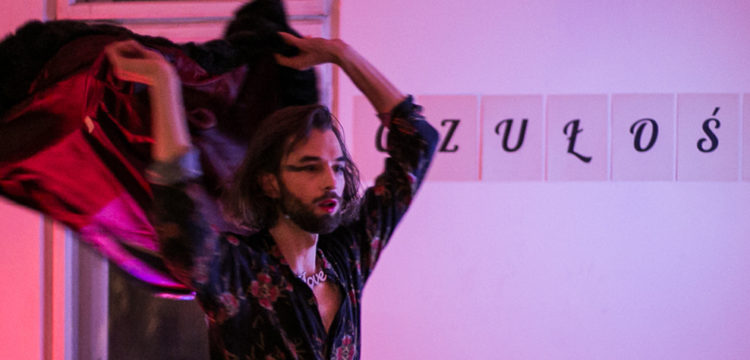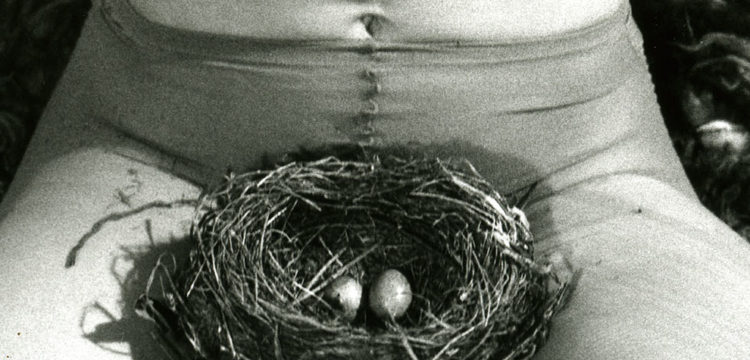The Involucre and the Weather
A dream to be able to use our incredible powers of transformation: on Phia Ménard’s Vortex
The Compagnie Non Nova was “founded in 1998 by Phia Ménard with the desire to approach juggling from a different angle, through the scenic and dramaturgical structure of each piece. ‘Non nova, sed nove’ (Not new things, but in a new way) is the company’s founding precept. The many multidisciplinary projects of the company have brought together artists, technicians, thinkers from various horizons with diverse experiences. It is not a collective but a professional team, with Phia Ménard in charge of the artistic direction.” Vortex and L’après-midi d’un Foehn are part of The Wind Plays and currently showing their transformative power at Teatro India.
There are several words in English to call an involucre: a covering, a casing, a shell, an envelope, a wrapper, a wrapping, a jacket. There are several levels of intensity on a wind force scale. There are different ways to name things inasmuch as there are subjective empirical ways of observing natural phenomena. Then there are standards that regulate both our language and habits.
Strong wind usually makes me restless—until you see the usual plastic bag caught into a maelstrom dance, that hypnotizes you and becomes an image that separates you from the usual stream of life. What is usual though? What is normal?

L’après midi d’un foehn, Cie Non Nova, © Jean Luc Beaujault.
L’après-midi D’un Foehn (Afternoon Of A Foehn) & Vortex premiered on October 2011, followed by foreword written by Phia Ménard herself—“I don’t follow any particular rules, I am an artist who observes the world with a desire to participate. To do this I try to understand who we are. Juggling and performance art are filters which allow me to distill what I see. I am convinced that we need to get away from the complacency of virtuosity, behind which it is so easy to hide. Personally, I don’t think that artists are here to change the world. But they can direct the spectator’s gaze onto a certain detail of the world. When creating art, Utopia is vital to me, I can affirm that now. I have chosen which side I’m on. I prefer to fight for art, for all forms of art, against the business culture which views a work of art as a convenience good. I don’t like things to be formatted. I prefer art which involves thought, reflection, convictions; art which defends the singularity and uniqueness of each individual and his, or her, actions. This is why I am inviting the audience to become involved in battles which they know in advance will be lost, rather than just watching them.”

L’après midi d’un foehn, Cie Non Nova, © Jean Luc Beaujault.
Breeze
When we enter the theatre, a large man is kneeling down on the edge of a round stage, surrounded with more or less twenty-five ventilators. The audience takes their sits all around, as if we were witnessing a trial. The large man has two plastic bags ahead. His skin is made of white plastic that looks like white tape, he’s wearing a hat and sunglasses, a grey elegant suit, which seems to fit him too tight. The soundscape is nothing but a slow beat, and the slow buzzing of somewhat four fans. He cuts off the plastic bags and re-tapes them together, he seems to know what he’s doing—the man making artifices. The wind start blowing and he sets the plastic bag free, which starts dancing, circularly. He pulls out more bags from his jacket, he dances with them as they float, although he moves heavily, the atmosphere is as light as childhood. Debussy’s playing and colorful puppets are gracefully dancing synchronized. Then the large man pulls off an umbrella, he traps the figures one by one, takes them off the wind stream, then set them free again and rageously destroys them one by one, rips them to pieces. Man makes, traps things (his children) into definitions, to the point of destruction. On stage, plastic waste all over. To clean that up means to take off the first layer: one’s clothes.
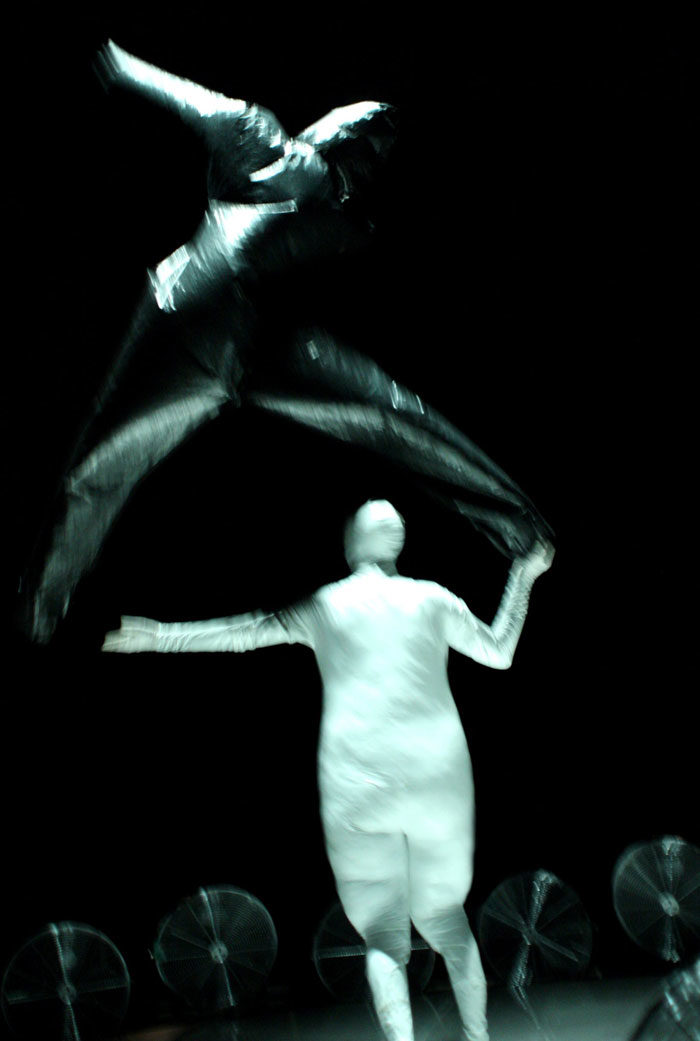
Vortex, Cie Non Nova, © Jean-Luc Beaujault.
High wind
The man ain’t a man any longer, but a formless dark figure, as heavy as the man. Longer arms, longer legs dragged in circles. Music becomes heavier and lights dimmer. The formless figure is dark and heavy, walks in rounds, until with spasms it frees itself from another outer layer that comes dancing on stage like a shadow. The agent body is now white, still large still plastic-like, fighting with a shadow way bigger than itself; it needs to knock it down, and to definitely get rid of it, the agent body literally trashes its shadow. The white figure still moves heavily, and we can see the torment and pain stemming out from its stomach, as it pulls out something similar to some infinite black plastic intestines, that makes its body lighter, but not less painful, and materializes on stage as a black informal mass, that turns into a tornado—meanwhile the light turned from white to red, and the reflections on the black plastic are realistically dramatic, showing the real atmospherical event, a less metaphorical vortex. At times, the plastic stream flies too low and gets hooked in the fans and some people outside the ring are aiding untangle the parts that got stock, as to remind us that despite inner tempestuous times, we should always count on some outside assistance.
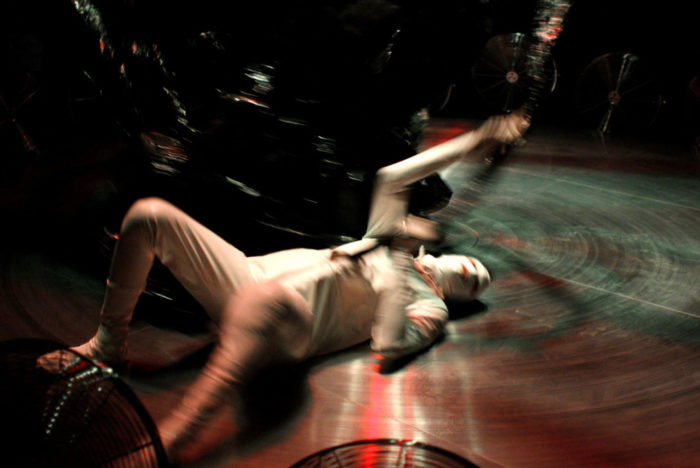
Vortex, Cie Non Nova, © Jean-Luc Beaujault.
Tornado
When the white body is devoid of its interior dark spills, and allows them to float them out its stomach, above, until it manages to prevaricate them and again takes a hold on them, as potentially destructive fears and—not effortlessly—disposes of them. There it lays to shed skin again when it gets rid of that last more visible layer of white plastic, and there a body remains, where we finally recognize something similar to what we know as skin—almost to the essence of things. There’s still a see-through layer of lycra, yet an extra layer constructing and constricting the body. Beside that, this body’s belly is pregnant. So the body bends down and rips off the tight under its crutch, from her genital she pulls off another plastic sheet, that creates a white vortex she dances with, and holds with her mouth, as if to get in control of language—another artifice which is one that floats fluid. With the wind, the laid down plastic sheet turns into a womb. Another being is born from the previous one, not out of nothing, but by addiction and subtraction.
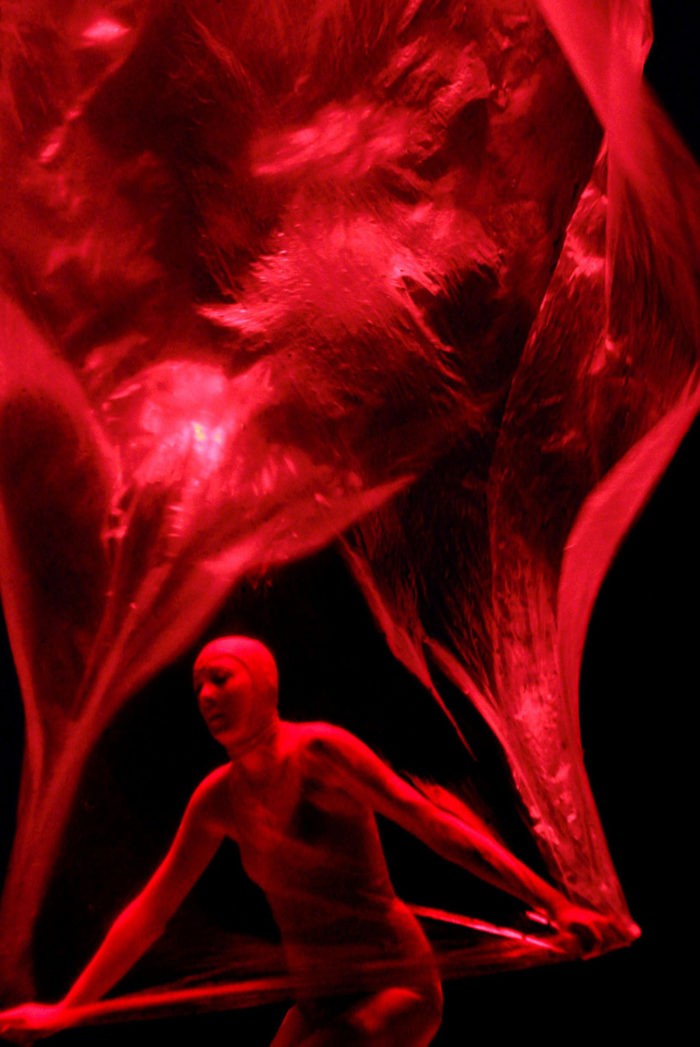
Vortex, Cie Non Nova, © Jean-Luc Beaujault.
Breathing
Out of the womb, the new self rips the extra useless layers of artificial skin off her body, finally reaching the most sincere outfit of it all: nakedness. Lights turn dimmer and dimmer until darkness. A darkness that entails some sort of peace, a silent night after the storm—to use a cliché.
I wanted to applaude for longer and scream. But I just kept applauding as long as the rest of the audience did. In the round setup I could see everybody’s faces and I knew some others wanted to do the same. I wonder whether we all saw our own transformations—past and to come—if we all remembered each moment we shed our skin and got rid of those layers that didn’t fit, or we didn’t want to be constituent of our essence, in order to become naked and inhabit the body we desire, each time ever again.




